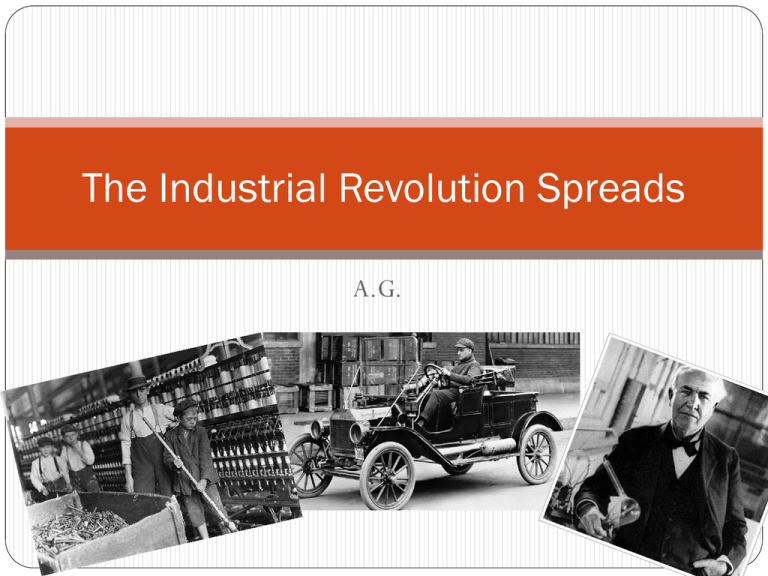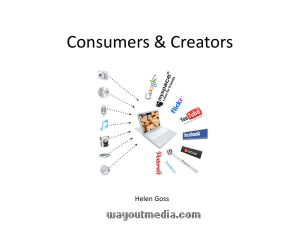
The Industrial Revolution Spreads
A.G.
Setting the Scene
By the 1880s, steel had replaced steam as the great symbol of the
Industrial Revolution
In huge steel mills, visitors watched with awe as tons of molten
metal were poured into giant mixers:
“…The flashing fireworks, the terrific gusts of heat, the gaping,
glowing mouth of the giant chest, the quivering light from the liquid
iron, the roar of a near-by converter…combine to produce an effect
on the mind that no words can translate.” –J.H. Bridge
The first phase of the revolution had largely been forged from
iron, powered by steam engines, and driven by the British textile
industry. By the mid-1800s, it entered a new phase
New factories, new sources of energy, and new processes turned
out new products
New Industrial Powers
During the early Industrial Revolution, Britain stood alone as
the world’s industrial giant and to protect itself, Britain tried
to enforce strict rules against exporting inventions
The rules worked until 1807 when British mechanic William
Cockerill opened factories in Belgium to manufacture
spinning and weaving machines
Belgium became the first European nation outside Britain to
industrialize
By the mid-1800s, other nations joined the race and
challenged Britain’s industrial supremacy
The New Pacesetters
Nations such as Germany, France, and the United States had more
abundant supplies of coal, iron, and other resources than did
Britain
Latecomers often borrowed British experts or technology
The first American textile was built with plans smuggled out of
Britain
Robert Fulton powered his steamboat with one of James Watt’s steam
engines
Two countries did move their way up to industrial power
Germany became a powerful nation in 1871 and within a few
decades, became Europe’s leading industrial power
The US advanced more rapidly and by 1900 was leading the world
in production
Uneven Development
Other nations industrialized more slowly, especially in
eastern and southern Europe
They didn’t have the resources or capital
Although Russia did have resources, social and political
conditions slowed its economic development
Russia didn’t industrialize until 100 years after Britain
Japan had remarkable success after 1868 despite the fact it
lacked many basic resources
Impact
The new industrial nations underwent rapid urbanization
Men, women, and children worked long hours in difficult
and dangerous conditions
The factory systems produced goods at a lower cost, so
workers were buying goods that only wealthy people in the
past could buy
The demand created jobs, and the building of cities,
railroads, and factories
Political leaders had to meet the demands of an industrial
society
Technology and Industry
Early in the Industrial Revolution, inventions such as the
steam engine were generally the work of gifted tinkerers
By the 1880s, companies hired professional chemists and
engineers to create new products and machinery
Steel
In 1856, British engineer Henry Bessemer developed a
process to purify iron ore and produce a new substance, steel
It was lighter, harder, and more durable than iron
Others improved the process to make steel more cheap
In 1880, the average German steel mill produced less than
five million metric tons of steel a year
By 1910, that number reached nearly fifteen million metric tons
Chemicals
Chemists created hundreds of new products, from medicines
such as aspirin to perfumes and soaps
Newly developed chemical fertilizers helped increase food
production
In 1866, Swedish chemist Alfred Nobel invented dynamite
It was widely used in construction and warfare
Dynamite earned him a huge fortune, which he willed to
fund the famous Nobel prizes that are still awarded today
Electricity
In the late 1800s, electricity replaced steam as the dominant
source of industrial power
Alessandro Volta actually developed the first battery in about
1800
Later, Michael Faraday created the first simple electric motor
and the first dynamo, a machine that generates electricity
Today, all electrical generators and transformers work on the
principle of Faraday’s dynamo
In the 1870s, Thomas Edison made the first electric light bulb
Edison’s “incandescent lamps” soon illuminated whole cities
Pace of city life quickened, and factories could work at night
New Methods of Production
Factories still used large numbers of workers and power-driven
machines to mass-produce goods throughout the 1800s
To improve efficiency, manufacturers designed products with
interchangeable parts, identical components that could be used in
place of one another
Interchangeable parts simplified assembly and repair
By the early 1900s, manufacturers introduced another new
method of production, the assembly line
The assembly line made production faster and cheaper,
lowering the price of goods
Technology Speeds Transportation and
Communication
Steamships replaced sailing ships, and railroad building took off
In Europe and North America, rail lines connected inland cities
and seaports, mining regions and industrial centers
In the US, a transcontinental railroad provided rail service from
the Atlantic to the Pacific
Russians did something similar with the Trans-Siberian Railroad
Passengers and goods rode on rails in India, China, Egypt, and
South Africa
The Automobile Age Begins
German engineer, Nikolaus Otto, invented a gasoline-
powered internal combustion engine
In 1886, Karl Benz received a patent for the first automobile
Which had three wheels and it wasn’t until a year later that the
first four-wheeled car came along
People laughed at the “horseless carriages”
American Henry Ford started making models that reached
the breathtaking speed of 25 miles an hour
In the early 1900s, Ford began using the assembly line to
mass-produce cars, making the US the leader in automobile
industry
Conquest of the Air
The internal combustion engine powered more than cars
Motorized threshers and reapers boosted farm production
It also made possible the dream of human flight
In 1903, two American bicycle makers, Orville and Wilbur
Wright, designed and flew a flimsy airplane at Kitty Hawk,
North Carolina
Commercial passenger travel, however, would not begin until
the 1920s
Rapid Communication
Samuel F. B. Morse developed the telegraph, which could
send coded messages over wires by means of electricity
His first telegraph line went into service between Baltimore
and Washington, D.C., in 1844
By the 1860s, messages could be sent between Europe and
North America
In 1876, Alexander Graham Bell patented the telephone
By the 1890s, Guglielmo Marconi invented the radio
In 1901, Marconi transmitted a radio message from Britain to
Canada, using Morse’s dot-and-dash code
New Directions for Business
New technologies required the investment of large amounts
of money
Entrepreneurs developed new ways of organizing business
Owners sold stock, or shares in their companies, to investors
Each stockholder became owner of a tiny part of a company
Rise of Big Business
By the late 1800s, big business came to dominate industry
Large-scale companies needed so much capital that they sold
hundreds of thousands of shares
The businesses formed giant corporations, businesses that are
owned by many investors who buy shares of stock
Stockholders risk only the amount they invest in the
company and cannot be held personally responsible for any
debts of the corporation
With large amounts of capital, corporations could expand
into many areas
Move Toward Monopolies
Powerful business leaders created monopolies and trusts
In Germany, Alfred Krupp inherited a steelmaking business
from his father
He bought up coal and iron mines as well as ore-shipping lines
that fed the steel business
Later, he and his son acquired plants that make tools, railroad
cars, and weapons
In the US, John D. Rockefeller built Standard Oil Company
of Ohio into an empire
By gaining control of oil wells, oil refineries, and oil pipelines,
he dominated the American petroleum industry
Move Toward Monopolies (Cont.)
To get a profit, ruthless business leaders destroyed competing
companies
With the competition gone, they were free to raise prices
A group of large corporations would join forces and form a
cartel, an association to fix prices, set production quotas, or
control markets
In Germany, a single cartel fixed prices for 170 coal mines
British, German, French, Dutch, and Japanese shippers came
close to setting freight rates on the sea lines of the world
Move Toward Regulation
The rise of big business sparked a stormy debate
Some people praised the Krupps and Rockefellers’ visions
and skills
They said their investment in things like railroad building
created jobs
Others called them “robber barons”
Said they damaged the free-enterprise system
By the 1900s, some governments did move against
monopolies
But the political and economic power of business leaders often
hindered efforts at regulation
Looking Ahead
By the late 1800s, European and American corporations were
setting up factories, refineries, and other production facilities
The bank invested vast sums in undertakings such as building
ports, railroads, and canals
As western capital flowed into Africa, Asia, and Latin
America, western governments became increasingly involved
in these areas
Review
Dynamo- a machine that generates electricity
Interchangeable Parts- identical components that could be used in
place of one another
Assembly Line- workers add parts to a product that moves along a
belt
Stock- shares in their companies
Corporation- business owned by many investors who buy shares of
stock
Cartel- an association to fix prices, set production quotas, or
control markets
Bessemer Process- Created a process to purify iron ore and turn
it into steel
Alfred Nobel- Swedish chemist who invented dynamite
Review (Cont.)
Michael Faraday- English chemist created first simple electric
motor dynamo
Thomas Edison- American inventor created the light bulb
Henry Ford- American manufacturer who first used the
assembly line to make cars
Orville and Wilbur Wright- American bicycle makers designed
and flew first airplane at Kitty hawk, North Carolina
Guglielmo Marconi- Italian inventor created the first radio,
transmitted Morse code from Great Britain to Canada in 1901
Alfred Krupp- German businessman who created a monopoly in
steel making industry
Review (Cont.)
How did the Industrial Revolution spread in the 1800s?
A British mechanic opened a factory in Belgium in 1807. Other
European countries, as well as the United States and Japan, eventually
learned British technology and created their own inventions
How did technology help industry expand?
Scientists developed new products and technologies. Their
achievements included a process fro producing steel, the development
of dynamite, and the creation of the dynamo for generating
electricity.
How did the need for capital lead to new business methods?
To raise needed capital, large companies became corporations and
sold shares of the business to investors.
Bibliography
http://webs.bcp.org/sites/vcleary/ModernWorldHistoryTextbook/IndustrialRevolution/Images/sweeper-and-doffer.jpg
http://1216.virtualclassroom.org/images/industrial_revolution6crop.jpg
http://www.topnews.in/files/Thomas-Edison-6466.jpg
http://www.thomasnet.com/articles/image/stainless-steel-tubes.jpg
http://www.biography.com/imported/images/Biography/Images/Profiles/F/Robert-Fulton-9304012-1-402.jpg
http://upload.wikimedia.org/wikipedia/commons/9/97/Racine_high-speed_steam_engine_(New_Catechism_of_the_Steam_Engine,_1904).jpg
http://upload.wikimedia.org/wikipedia/commons/thumb/1/10/Henry_Bessemer.jpg/220px-Henry_Bessemer.jpg
http://www.nobelprize.org/alfred_nobel/biographical/articles/life-work/images/alfred1.jpg
http://silverstallion2.tripod.com/sitebuildercontent/sitebuilderpictures/dynamo.gif
http://www.edisonmuckers.org/wp-content/uploads/2011/02/Early-Light-Bulb.jpg
http://upload.wikimedia.org/wikipedia/commons/thumb/2/29/Ford_assembly_line_-_1913.jpg/220px-Ford_assembly_line_-_1913.jpg
http://www.findingdulcinea.com/docroot/dulcinea/fd_images/news/on-this-day/September-October-08/On-this-Day--The-First-Model-T-Ford-IsProduced/news/0/image.jpg
http://www.leaderbird.com/wp-content/uploads/2013/02/wright-brothers.jpg
http://w1tp.com/0050b.jpg
http://whatcanilearntoday.files.wordpress.com/2012/02/first-phone.jpg
https://missmanganssciencesite.pbworks.com/f/radio_picture_king%255B1%255D.jpg
http://upload.wikimedia.org/wikipedia/commons/thumb/0/0c/Alfred_Krupp.jpg/728px-Alfred_Krupp.jpg
http://upload.wikimedia.org/wikipedia/commons/6/6f/John_D._Rockefeller_1885.jpg
Created by Ahria Golden “All Rights Reserved”





